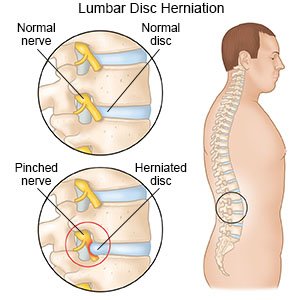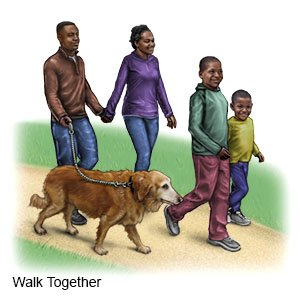Lumbar Disc Herniation
Medically reviewed by Drugs.com. Last updated on Aug 4, 2025.
What is lumbar disc herniation (LDH)?
LDH occurs when a disc in your lumbar spine (lower back) bulges out. Discs are spongy cushions between the vertebrae (bones) in your spine. The herniated disc may press on your nerves or spinal cord.
 |
What increases my risk for LDH?
Aging increases your risk for LDH because your discs weaken and shrink as you get older. This causes the disc to lose its cushion and bulge out between your vertebrae. The following also increase your risk for LDH:
- Back strain caused by heavy lifting
- Repetitive activities that strain your back, such as jobs that require pulling, bending, or twisting
- Frequent driving
- Having overweight
- Not getting regular physical activity
- Cigarette smoking
What are the signs and symptoms of LDH?
Mild herniation may not cause any signs or symptoms. You may have any of the following if the herniated disc presses against your nerves or spinal cord:
- Pain in your lower back, buttocks, groin, or legs
- Back pain that gets worse when you sit
- Burning, stabbing, or tingling pain that shoots down one or both legs
- Numbness or weakness in one leg
- Trouble bending at the waist
- Trouble walking or moving your feet or toes
How is LDH diagnosed?
Your healthcare provider will ask you about your symptoms and any health problems you may have. Your provider may examine your spine for any abnormal areas. Tell your provider if any area on your spine is painful when touched. Your provider may also check the reflexes in your ankles and knees. X-ray pictures may be used to check for other problems causing your symptoms. You may also need any of the following tests:
- A straight leg raise test is done to check if your disc is pressing against your nerves or spinal cord. Your provider will ask you to lie flat on your back, with your legs straight. Then each leg will be raised as far as possible without pain.
- An MRI or CT scan may show the bulging disc. You may be given contrast liquid to help the disc show up better in the pictures. Tell the healthcare provider if you have ever had an allergic reaction to contrast liquid. Do not enter the MRI room with anything metal. Metal can cause serious injury. Tell the healthcare provider if you have any metal in or on your body.
- A myelography is an x-ray or CT scan of your spinal cord. Contrast liquid will be given as an injection into the area around your spinal cord before the pictures are taken.
Related medications
How is LDH treated?
Your healthcare provider may have you rest in bed for a few days. It is best to rest on your side with your knees bent. Put a cushion between your knees to help decrease the pressure on your spine and nerves. You may also need any of following:
- NSAIDs , such as ibuprofen, help decrease swelling, pain, and fever. This medicine is available with or without a doctor's order. NSAIDs can cause stomach bleeding or kidney problems in certain people. If you take blood thinner medicine, always ask your healthcare provider if NSAIDs are safe for you. Always read the medicine label and follow directions.
- Prescription pain medicine may be given. Ask your healthcare provider how to take this medicine safely. Some prescription pain medicines contain acetaminophen. Do not take other medicines that contain acetaminophen without talking to your healthcare provider. Too much acetaminophen may cause liver damage. Prescription pain medicine may cause constipation. Ask your healthcare provider how to prevent or treat constipation.
- Muscle relaxers decrease pain from muscle spasms.
- A steroid injection may be given to reduce inflammation. Steroid medicine is injected into the epidural space. The epidural space is between your spinal cord and vertebrae. You may be given pain medicine along with the steroids.
- Physical therapy may be recommended by your healthcare provider. A physical therapist teaches you exercises to help improve movement and strength, and to decrease pain. A physical therapist can teach you safe ways to bend, lift, sit, and stand to help relieve back pain.
- Surgery may be needed to fix your herniated disc if other treatments have failed. Surgery may be done to remove your herniated disc and make your spine stronger. Surgery may also be done to decrease pressure on your nerves and spinal cord.
How can I manage or prevent a LDH?
- Apply heat to decrease pain and muscle spasms. Apply heat on your lower back for 20 to 30 minutes every 2 hours for as many days as directed.
- Do low-stress exercise and activity. Exercises that do not stress your back muscles may help decrease your pain. Examples of low-stress exercises are walking, swimming, and biking. Avoid heavy lifting while your back is healing. Try not to sit for long periods of time. Talk to your healthcare provider before you start any new exercise program.

- Do not smoke. Nicotine can damage blood vessels and make it more difficult to manage a LDH. Smoking also increases your risk for another herniation and delays healing after treatment. Ask your provider for information if you currently smoke and need help to quit. E-cigarettes or smokeless tobacco still contain nicotine. Talk to your provider before you use these products.
When should I seek immediate care?
- You cannot control when you urinate or have a bowel movement.
- You are not able to move one or both legs.
- You lose feeling in your groin or buttocks.
When should I call my doctor?
- You have numbness in one or both legs.
- You have low back pain while resting.
- You have trouble moving one or both legs.
- You begin leaking urine or bowel movement.
- Your pain gets worse, even after you take your pain medicine.
- You have questions or concerns about your condition or care.
Care Agreement
You have the right to help plan your care. Learn about your health condition and how it may be treated. Discuss treatment options with your healthcare providers to decide what care you want to receive. You always have the right to refuse treatment. The above information is an educational aid only. It is not intended as medical advice for individual conditions or treatments. Talk to your doctor, nurse or pharmacist before following any medical regimen to see if it is safe and effective for you.© Copyright Merative 2025 Information is for End User's use only and may not be sold, redistributed or otherwise used for commercial purposes.
Learn more about Lumbar Disc Herniation
Care guides
Further information
Always consult your healthcare provider to ensure the information displayed on this page applies to your personal circumstances.
